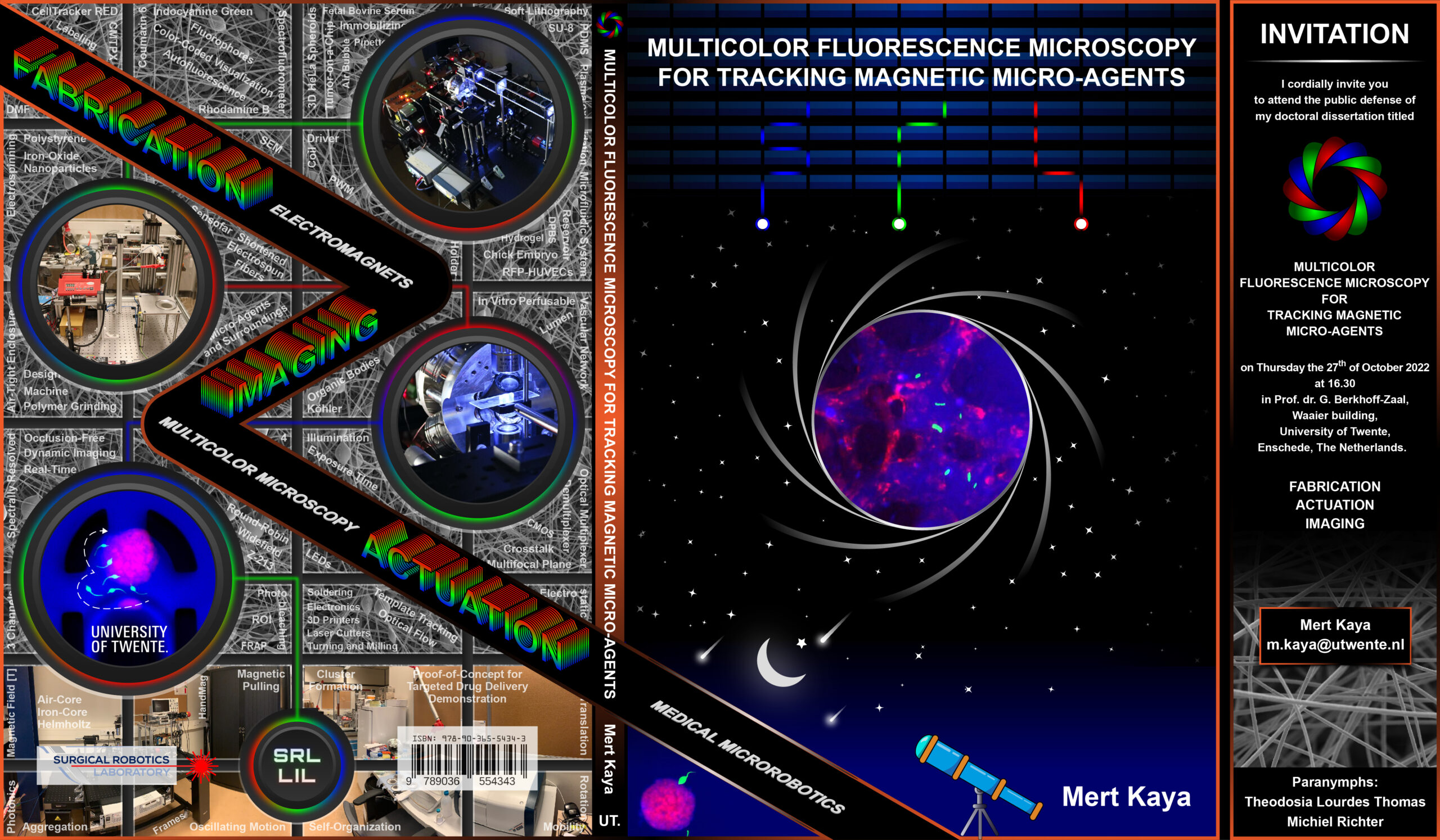
Doctoral defense – Mert Kaya
SRL doctoral candidate defends thesis.
The defense of the doctoral thesis titled “Multicolor Fluorescence Microscopy for Tracking Magnetic Micro-Agents” by Mert Kaya was held on Thursday, 27th of October 2022 at 4:30 pm in the Waaier 3 at the University of Twente. The doctoral thesis is available here. The recording of the defense ceremony is also available here.
Thesis summary:
 The field of microrobotics opens the door to new therapeutic interventions by providing access to hard-to-reach regions of the human body. The envisioned interventions are based on the wireless movement of the micro-agents, part of the microrobotics systems designed to interact with the environments, using external stimuli (e.g., magnetic, sound, light, chemical, temperature). Although a wide variety of micro-agents have been designed, fabricated, and actuated, sensor integration remains a challenge due to size limitations. In order to understand and verify the functionality of the micro-agents, imaging modalities are utilized as external sensors and considered the only feedback source. Since experimental testbeds are fabricated using optically transparent materials, microscopy techniques have been extensively used in preliminary tests and lab-on-a-chip applications.
The field of microrobotics opens the door to new therapeutic interventions by providing access to hard-to-reach regions of the human body. The envisioned interventions are based on the wireless movement of the micro-agents, part of the microrobotics systems designed to interact with the environments, using external stimuli (e.g., magnetic, sound, light, chemical, temperature). Although a wide variety of micro-agents have been designed, fabricated, and actuated, sensor integration remains a challenge due to size limitations. In order to understand and verify the functionality of the micro-agents, imaging modalities are utilized as external sensors and considered the only feedback source. Since experimental testbeds are fabricated using optically transparent materials, microscopy techniques have been extensively used in preliminary tests and lab-on-a-chip applications.
Single-band fluorescence and bright-field microscopy are commonly used to visualize the micro-agents with spatiotemporal resolution. However, single-band fluorescence microscopy renders visualization of only micro-agents and does not provide information about physical surroundings. Clear visualization of surroundings, as well as the micro-agents, is a requirement to reach the desired location. Bright-field microscopy enables visualization of micro-agents and surroundings, but acquired images do not reveal encoded information about identification and distinction. In this thesis, multicolor fluorescence microscopy is first applied for visualizing magnetically-actuated micro-agents and dynamic surroundings by relatively fast spectrum band change (multiplexing). The main difference of multicolor microscopy is that a sample containing micro-agents is fully resolved in different spectrum bands, and color-coded visualization is acquired. Since color is a visual cue for detection, acquired images enable an increased understanding of the micro-agent functionality and clear distinction of the surrounding media. This thesis aims to fill the gap in the literature on performing real-time multicolor microscopy for micro-agents and surroundings with three parts divided into six chapters.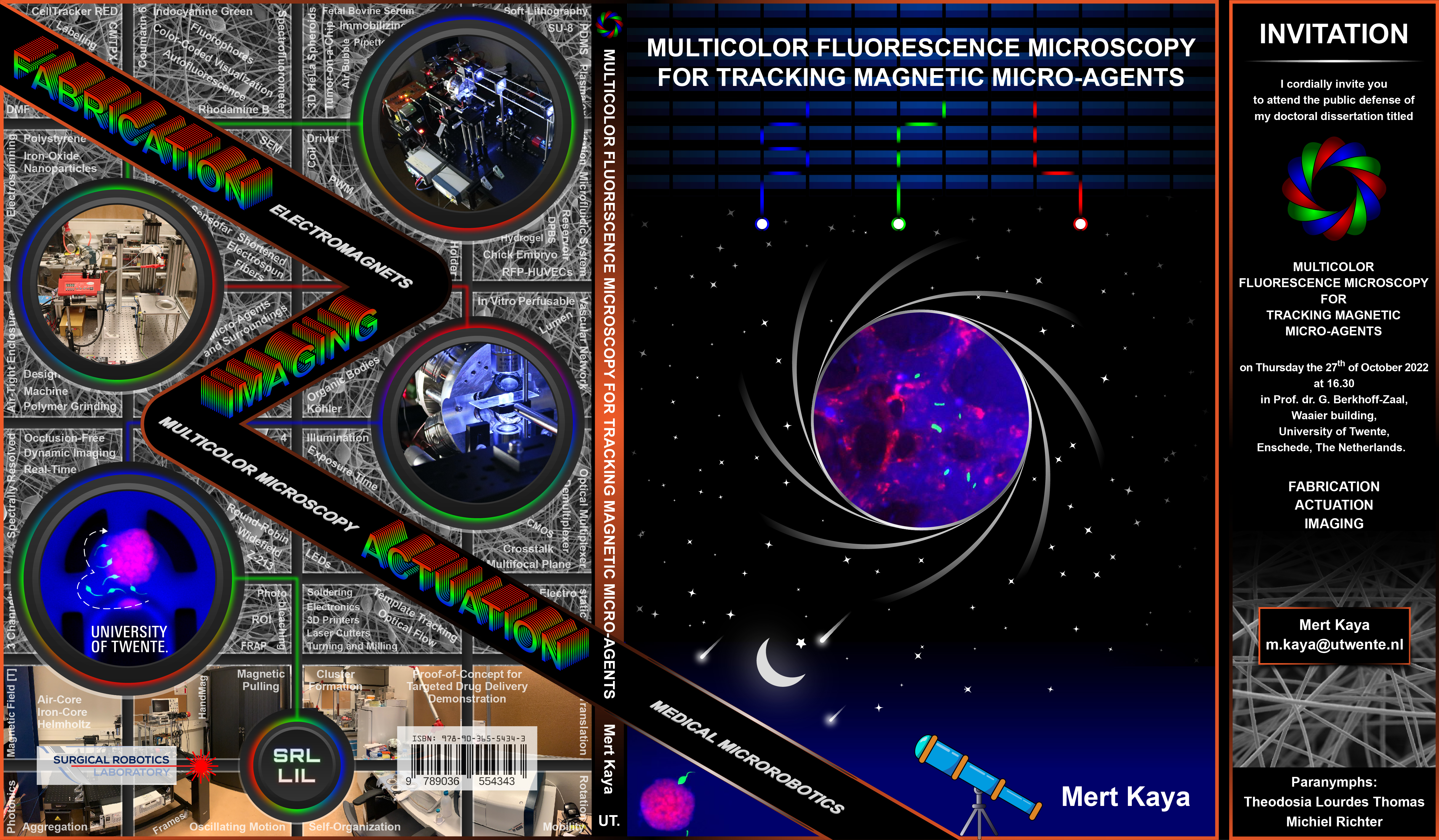
Chapter 1 provides an overview of micro-agents, multicolor microscopy, and research questions tackled in this thesis. Subsequently, Part I (Chapters 2-4) describes the imaging, actuation, and tracking tools. A multicolor fluorescence microscope is developed to excite the fluorophores in a round-robin manner and synchronously acquire images from three distinct spectrum bands.
Chapter 2 includes the microscope design, fluorophore selection, and spectrum analysis. A tumor environment is created by randomly placing cancer spheroids (formed with cervical HeLa cells) and polystyrene beads as drug carriers in a microfluidic channel. The environment is employed to validate that the microscope generates images with unambiguous color coding by spectral crosstalk analysis. Real-time multicolor microscopy is demonstrated by visualizing the attachment of the beads to a cancer spheroid utilizing electrostatic forces as a method for biohybrid drug carrier fabrication. The microscope is coupled with an orthogonal array of four iron-core coils to mobilize micro-agents using magnetic fields. The coils are individually powered using custom-made driver circuits.
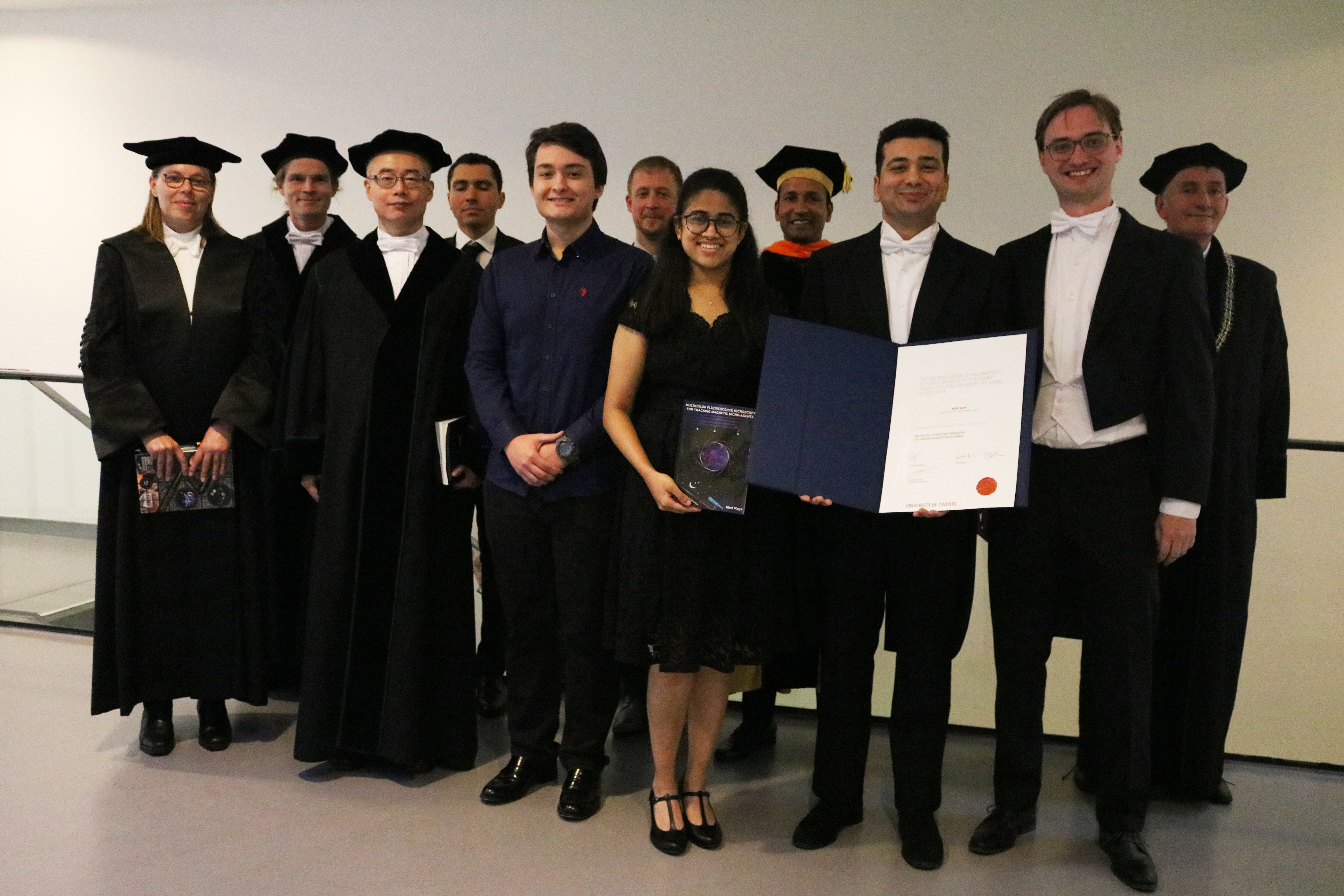 Chapter 3 presents the coil driver architecture designed for magnetic manipulation of the micro-agents. A multilayer shielding enclosure is designed to prevent degradation of measurement and control signals by possible penetration of stray magnetic and electromagnetic waves. Finite element analysis shows that the shielding enclosure generates a low-resistance path for both magnetic and electromagnetic waves. Helmholtz, air-core, and iron-core coils are individually employed to experimentally validate that the driver is able to power different coil configurations. The effect of pulse width modulation (PWM) on the magnetic field and ohmic losses is observed at varying carrier frequencies and duty cycles. Experiments and finite element simulations reveal that magnetic field fluctuations minimize when PWM carrier frequencies are selected close to the self-resonant frequencies of the coils. In order to obtain automated quantitative data about actuated micro-agents through the generated magnetic fields, a visual tracker is implemented.
Chapter 3 presents the coil driver architecture designed for magnetic manipulation of the micro-agents. A multilayer shielding enclosure is designed to prevent degradation of measurement and control signals by possible penetration of stray magnetic and electromagnetic waves. Finite element analysis shows that the shielding enclosure generates a low-resistance path for both magnetic and electromagnetic waves. Helmholtz, air-core, and iron-core coils are individually employed to experimentally validate that the driver is able to power different coil configurations. The effect of pulse width modulation (PWM) on the magnetic field and ohmic losses is observed at varying carrier frequencies and duty cycles. Experiments and finite element simulations reveal that magnetic field fluctuations minimize when PWM carrier frequencies are selected close to the self-resonant frequencies of the coils. In order to obtain automated quantitative data about actuated micro-agents through the generated magnetic fields, a visual tracker is implemented.
Chapter 4 introduces a visual tracking framework to localize various micro-agent types without specific detection and thresholding procedures. The working mechanism of the framework is based on computing the motion of a micro-agent between two consecutive frames using optimization techniques. In order to model the motion and compensate for the intensity fluctuations, the photometric affine function is selected. Pyramidal implementation of the framework is 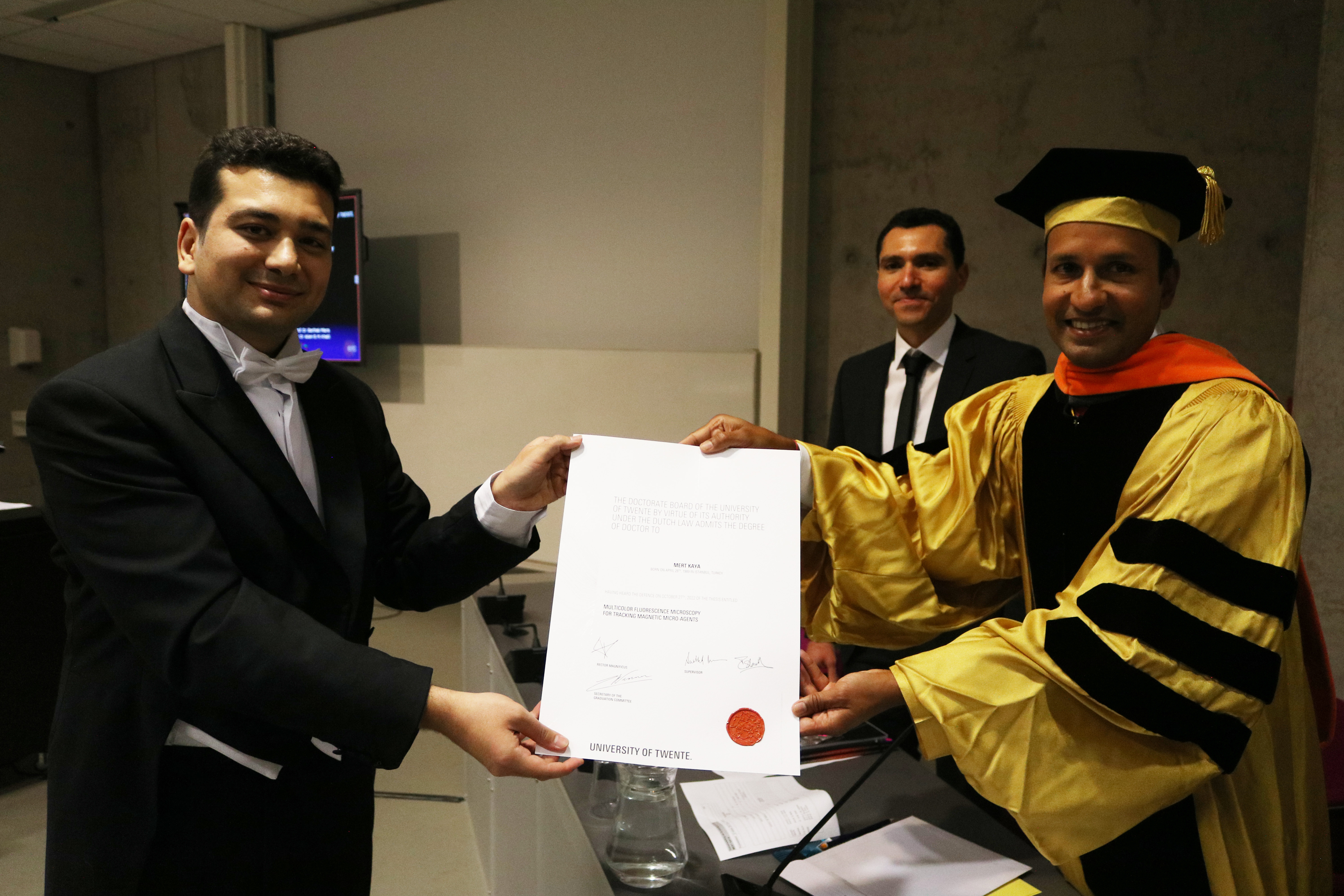 employed to render tracking of the micro-agents under the large motion displacements and prevent failures. The framework is combined with multi-rate state estimators for its usage in control applications by upsampling the actual image acquisition rate. The accuracy of the multi-rate state estimation is measured using high-speed bright-field imaging. The scientific tools introduced in Chapters 2-4 are used in Chapter 5 to acquire and analyze the multicolor images through experiments where the micro-agents are manipulated using magnetic fields.
employed to render tracking of the micro-agents under the large motion displacements and prevent failures. The framework is combined with multi-rate state estimators for its usage in control applications by upsampling the actual image acquisition rate. The accuracy of the multi-rate state estimation is measured using high-speed bright-field imaging. The scientific tools introduced in Chapters 2-4 are used in Chapter 5 to acquire and analyze the multicolor images through experiments where the micro-agents are manipulated using magnetic fields.
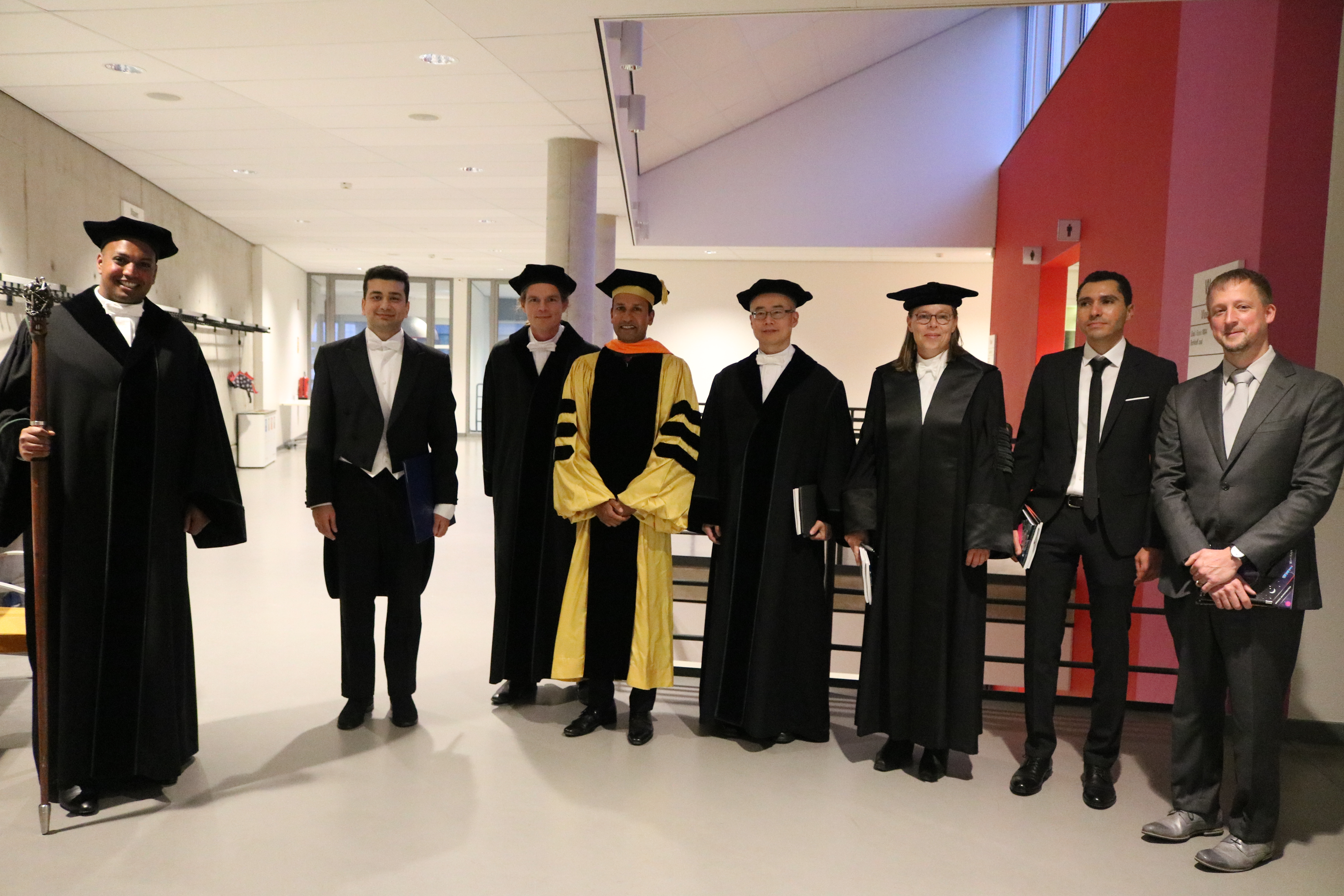 Part II (Chapter 5) demonstrates the performance of real-time multicolor microscopy by visualizing micro-agents within 3D tumor-on-a-chip and vascular networks. The electrospinning technique is employed to fabricate magnetic and fluorescent micro-agents with relatively high photobleaching resistance. In order to visualize and measure sequential motion, cancer cell spheroids are actuated with the micro-agents in an open reservoir. A microfluidic chip is designed to create a tumor model, immobilize a single cancer spheroid in a fixed location, and provide a confined space for multicolor image acquisition. Single and cluster micro-agents are attached to the immobilized cancer spheroids as a proof-of-concept targeted drug delivery demonstration. Dynamic multicolor imaging reveals that the microfluidic chip maintains the cancer spheroids for long-term microscopy. In vitro perfusable vascular network and ex ovo chorioallantoic membrane are used to acquire spectrally resolved visualization of micro-agents in vascularized environments. Imaging experiments show that multicolor microscopy renders color-coded visualization of polymeric micro-agents, organic bodies (cancer spheroids and vessels), and surrounding media in real time.
Part II (Chapter 5) demonstrates the performance of real-time multicolor microscopy by visualizing micro-agents within 3D tumor-on-a-chip and vascular networks. The electrospinning technique is employed to fabricate magnetic and fluorescent micro-agents with relatively high photobleaching resistance. In order to visualize and measure sequential motion, cancer cell spheroids are actuated with the micro-agents in an open reservoir. A microfluidic chip is designed to create a tumor model, immobilize a single cancer spheroid in a fixed location, and provide a confined space for multicolor image acquisition. Single and cluster micro-agents are attached to the immobilized cancer spheroids as a proof-of-concept targeted drug delivery demonstration. Dynamic multicolor imaging reveals that the microfluidic chip maintains the cancer spheroids for long-term microscopy. In vitro perfusable vascular network and ex ovo chorioallantoic membrane are used to acquire spectrally resolved visualization of micro-agents in vascularized environments. Imaging experiments show that multicolor microscopy renders color-coded visualization of polymeric micro-agents, organic bodies (cancer spheroids and vessels), and surrounding media in real time.
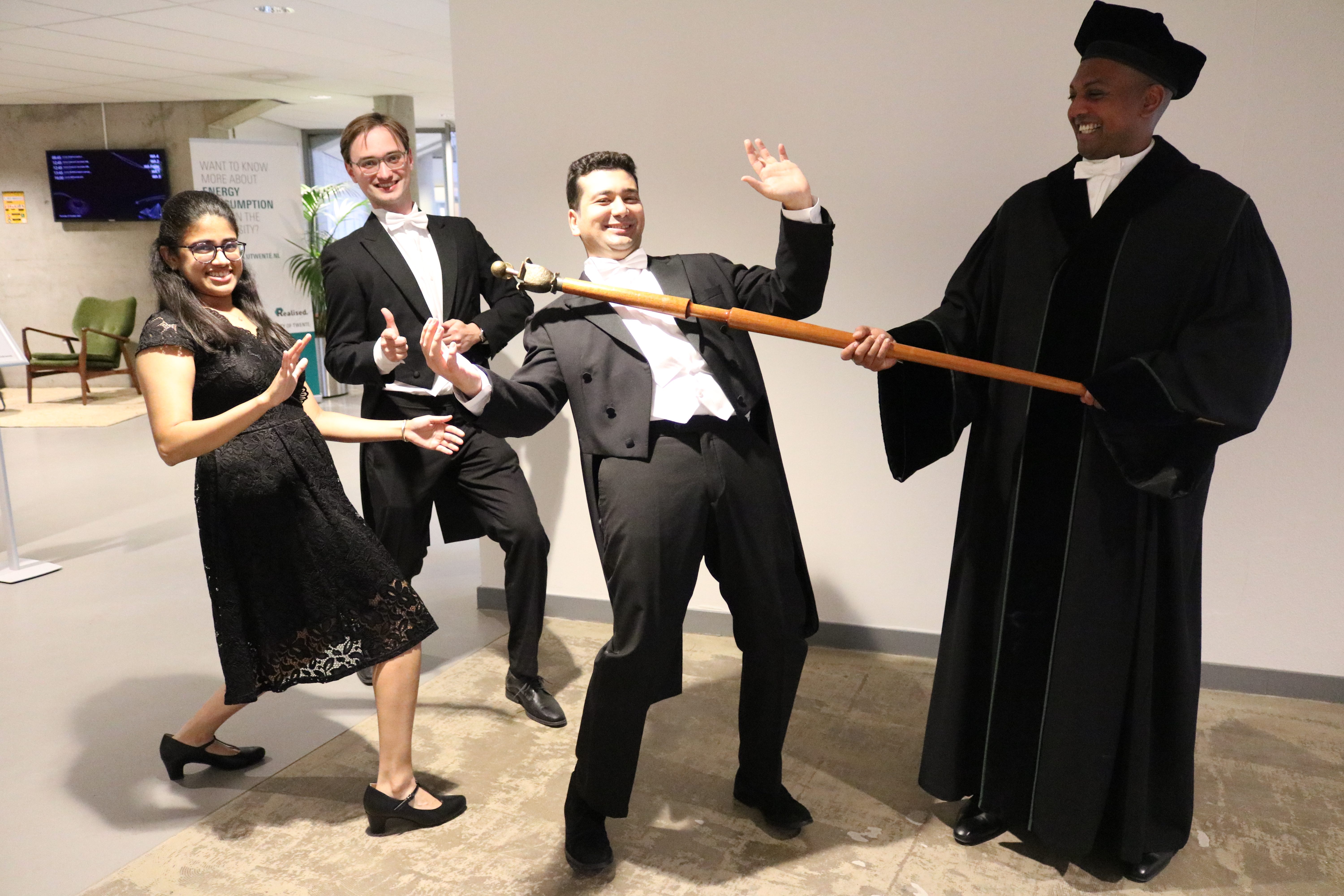 Part III (Chapter 6) concludes this thesis by highlighting the main contributions and future implications. Chapter 6 first presents the conclusions of research conducted in Chapters 2-5 and couples them with potential applications in the field of microrobotics. The subsequent section provides an outlook for follow-up research studies. Guidelines are suggested for fabricating therapeutic micro-agents and monitoring their efficacy on live cells using multicolor microscopy. The microscope-in-a-catheter concept is proposed for real-time multicolor image acquisition of micro-agents inside the tissue. This concept holds the potential to accelerate the clinical translation of micro-agents by enabling visualization of drug release under in vivo conditions.
Part III (Chapter 6) concludes this thesis by highlighting the main contributions and future implications. Chapter 6 first presents the conclusions of research conducted in Chapters 2-5 and couples them with potential applications in the field of microrobotics. The subsequent section provides an outlook for follow-up research studies. Guidelines are suggested for fabricating therapeutic micro-agents and monitoring their efficacy on live cells using multicolor microscopy. The microscope-in-a-catheter concept is proposed for real-time multicolor image acquisition of micro-agents inside the tissue. This concept holds the potential to accelerate the clinical translation of micro-agents by enabling visualization of drug release under in vivo conditions.
Promotor
- Prof. Dr. S. Misra (University of Twente/University Medical Center Groningen, The Netherlands)
Thesis Committee
- Prof. Dr. Ir. H. F. J. M. Koopman (University of Twente, The Netherlands) – Chair
- Dr. I. S. M. Khalil (University of Twente, The Netherlands) – Co-supervisor
- Prof. Dr. Q. Zhou (Aalto University, Finland)
- Prof. Dr. I. S. Zuhorn (University Medical Center Groningen, The Netherlands)
- Prof. Dr. I. M. Vellekoop (University of Twente, The Netherlands)
- Dr. J. Rouwkema (University of Twente, The Netherlands)
